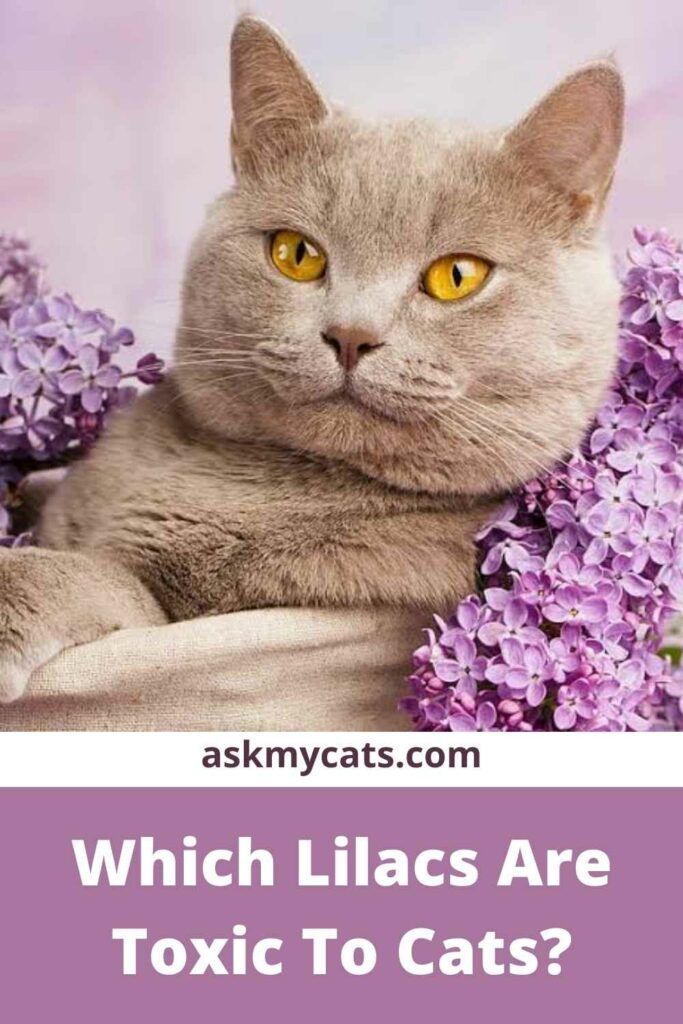Lilac bushes have been popular for several generations and are still a common sight in many yards and gardens. Lilacs contain no poisons or compounds that can harm humans or animals, and they do not irritate the skin.
From the tops of their branches to the ends of their roots, lilacs are poison-free. The blooms of the lilac are, in fact, edible.
If you’ve heard that lilacs are toxic, you’re probably thinking of the Persian Lilac, also known as the Chinaberry tree.
While the common lilac plant (Syringa vulgaris) is not toxic or poisonous, animals’ stomachs and digestion may be affected if they eat the plant or its components.
Although lilac does not usually feature on lists of plants that are harmful to cats, some lilac species are poisonous to cats. Depending on how much lilac your cat has eaten, it might cause serious illness.
Cats are inherently inquisitive animals. Anything fresh in their environment, including plants, will pique their interest. Cat poison is found in many common plants and can damage your pet. The lilac plant isn’t generally included in lists of plants that are harmful to cats, although certain lilac species are.
In this article, we will explain the relationship between lilacs and your feline friend so, keep reading!


Give Your Cat the Perfect Day
Get the Free Ebook!
Are Cats Attracted To Lilac?
While cats are inquisitive and will investigate everything in your home or yard, lilacs appear to have unique characteristics that attract cats.
First and foremost, these plants are quite beautiful, particularly when they bloom and have flowers. Though cats don’t have the same colour perception as humans, they can tell the difference between brilliant and dull hues.
As a result, one of the explanations for your cat’s fondness for lilac flowers in full bloom might be their beautiful hue.
Lilacs, on the other hand, have a strong fragrance. It’s worth noting that cats have a keen sense of smell and can detect even the slightest odors in their surroundings.
What isn’t known is if they smell in the same way that we do. However, everything that emits a fragrance is worth exploring in the feline world.
So, depending on how you look at it, there are a variety of reasons why your cat could be drawn to lilac.
Are Lilac Stems Poisonous?
While lilac blossoms are not always toxic, the stems are more likely to cause choking. As a result, cats should avoid eating lilac stems as well.
Anything can go wrong if the lilac is one of the poisonous varieties. Therefore, make sure that your cat does not consume any lilac stem.
Are Lilac Leaves Poisonous?
Cats are not poisoned by lilacs. These shrubs or plants are common in people’s gardens and do not hurt pets if they lick or eat them.
However, poisonous lilac species have the highest concentration of hazardous compounds in their leaves.
Lilac leaves are poisonous to cats. Vomiting, lethargy, diarrhea, and convulsions are among symptoms of plant poisoning in cats.
Which Lilacs Are Toxic To Cats?
There are different varieties of lilacs that may be toxic to cats. They are:

1. Common Lilac
This is the lilac plant that you’re probably acquainted with, scientifically known as Syringa vulgaris. This lilac variant is extremely common.
Lilac-colored blooms and an appealing scent distinguish the common lilac. The plants often reach a height of 20 feet.
Common white lilacs are the least harmful to cats in terms of toxicity, which is a good thing given they’re the most common lilac kind.
2. Persian Lilac
Persian lilacs, also known as chinaberry tree or white cedar, are smaller than their ordinary cousins, reaching only around 8 feet in height.
These plants produce light lilac blooms that are likewise much smaller than ordinary lilac blossoms.
Melia toxins A and B are found in the seeds of Persian lilacs, which accounts for the plant’s toxicity to cats. Vomiting, diarrhea, drooling, tremors, and muscular spasms are all symptoms of poisoning.
3. French Lilac
French lilacs are among the most uncommon lilac variety. They bloom just for a few weeks in the spring and summer.
When in bloom, its flowers come in a variety of hues, including white, pink, blue, and purple.
Goats rue and professor weed are some of the other names for French lilacs.
They contain galegin, a neurotoxic and hypotensive substance that is extremely poisonous to cats. Ingesting this substance can result in a variety of problems, including pulmonary edema, hydrothorax, and even death.
The lilac variety in question is something to be concerned about. Therefore, be careful about the kind of lilac plant you expose to your pet.
Can Lilacs Kill Cats?

Lilacs are typically harmless for cats, but if they are eaten, they can be poisonous. Constipation, diarrhea, and stomach discomfort are just a few of the gastrointestinal side effects to be aware of.
Cats are obligate carnivores, so keep that in mind. As a result, plant stuff is seen as a foreign material by their digestive tract.
As a result, eating lilac in any quantity may induce stomach discomfort in your cat, leading to a variety of gastrointestinal problems.
The severity of the adverse effects varies depending on how much and what portion of the plant the cat ate.
If the lilac in question is one of the types that isn’t poisonous to cats, there shouldn’t be any serious adverse effects other than slight stomach discomfort. That is true regardless of which portion of the plant your cat has consumed.
The foliage and seeds of deadly lilac variants, on the other hand, may be more toxic than the blooms. This is because the deadly compounds found in hazardous plants are generally concentrated in the plant’s leaves. The intensity of the toxicity tends to decrease as the plants bloom.
Therefore, certain varieties of lilac does have the potential to kill your feline in ingested in large amounts.
What Are The Symptoms of Lilac Poisoning?
Animals are generally not poisoned by the common lilac plant (Syringa vulgaris). If you believe your pet has eaten pieces of a lilac shrub, you should seek guidance from your veterinarian.
Gastrointestinal problems are the most prevalent side effect of plant consumption. Your cat’s digestion may be affected by the ingestion of plant material.
Here are some typical indications to check for if you believe your cat has lilac poisoning:
- Stomach upset
- Vomiting
- Diarrhea
- Drooling
- Loss of appetite
- Difficulty walking or a staggering walk
- Lethargy
- Excessive thirst
- Urination
- Nervousness
- Seizure
- Difficulty in breathing
Contact your veterinarian if your cat’s symptoms become more severe.
Is French Lilac Poisonous To Cats?
Large, robust, and adaptable shrubs, French Lilacs are popular. Once established, they can withstand dryness and poor soil, but avoid planting in rainy regions.
This cultivar blooms in mid-spring with clusters of periwinkle-blue flowers. In the fall, the deep green foliage change a yellow-purple colour.
According to research, the French lilac is toxic and poisonous to cats. It’s also known as professor weed or goats rue.
Galegin, which is a neurotoxic and hypotensive compound found in French Lilac, is to blame for the toxicity. Acute death is caused by massive pulmonary edema, hydrothorax, and fluid build-up in other organs.
Animals either perish quickly or adapt to the plant, allowing them to consume greater amounts of it. Try to keep your furry friend away from this variety of lilac.
Are White Lilacs Poisonous To Cats?
The common white lilac is a fragrant ornamental shrub with beautiful blooms. The beauty and smell of the common white lilac are well-known and adored by gardeners all around the world. In mid-spring, its pure white blooms emerge on tall, erect panicles.
The dark green, heart-shaped leaves complement the clustered flowers elegantly. Your white lilac’s scent will astonish you. It is one of a plant’s most potent scents.
Common lilacs are the least harmful to cats in terms of toxicity, which is a good thing given they’re the most common lilac kind.
Why Does My Cat Like My Lilac Bush?

With their enormous clusters of beautiful, fragrant blooms, lilac bushes are a feast for the eyes and nose. This is the reason why your feline is attracted to your lilac bush.
If your pets desire a taste of the bush, don’t worry. The plants aren’t dangerous to animals and are completely non-toxic to people.
Lilacs do not contain any compounds that might harm animals or people, and they do not irritate the skin. However, the American Society for the Prevention of Cruelty to Animals (ASPCA) encourages pet owners with lilac bushes to be cautious.
Contact your veterinarian if you believe an animal or pet has eaten lilac bushes to assist relieve the animal’s stomach problems.
While lilac bushes are unlikely to be harmful to cats, any intake of plants and their components by animals might cause stomach and digestive problems. Be careful of the French lilac, Galega officinalis, as it is extremely toxic to cats and may even cause death.
From the tops of their branches to the ends of their roots, lilac bushes are poison-free. Even yet, keeping the family cat from munching on the shrubs is a smart idea.
Twigs and leaves may become lodged in their throats, and too much roughage may cause stomach distress. Furthermore, using chemical pesticides on your lilacs may expose your dogs to poisons.
To be safe, keep an eye on them while they’re around your plants and use non-toxic chemicals to safeguard your garden wherever feasible.
What Should I Do If My Cat Is Sick After Eating Lilac?
Poisoning symptoms should be reported to your veterinarian as soon as possible. If you get treatment right away, your pet has the highest chance of surviving.
We recommend that you try to maintain a peaceful environment for your pet.
Wrap your cat in a blanket and take her to the veterinarian as soon as possible, along with the suspected poison container, plant, or leaf.
Do give your pet any anti-vomiting or anti-diarrhea medicines without first consulting your veterinarian. Trying to prevent vomiting isn’t always a good idea. Your pet’s vomiting might be assisting in the removal of the poisonous material.
We recommend that you contact your veterinarian and get to him as soon as possible. Your feline may get well if she gets treatment soon enough.
Frequently Asked Questions
Are Lilacs Safe For Cats?
Cats are typically safe with lilacs. The Persian lilac, on the other hand, is extremely poisonous to cats. If eaten, the Persian lilac can produce stomach pains, muscular weakness, tremors, and convulsions.
Is The Smell Of Lilacs Toxic To Cats?
No, cats are not poisoned by the scent of lilacs. Lilacs have a strong yet lovely scent, which is said to be one of the reasons cats are drawn to them.
Is Lilac Bush Poisonous To Cats?
Cats are not poisoned by lilac bush. They are non-toxic to your kitty companion.
Final Words
Cats are naturally inquisitive creatures. They like playing with almost anything they can get their paws on, including indoor plants.
If you have indoor plants, you may have noticed that your cat inspects them from time to time, even going so far as to sniff or chew on them.
If you have plants around or within your home, be especially cautious. If you see your cat acting strangely after consuming lilac, take her to the veterinarian as soon as possible.
Drop down your doubts and queries below in the comment section. We will answer them soon!
